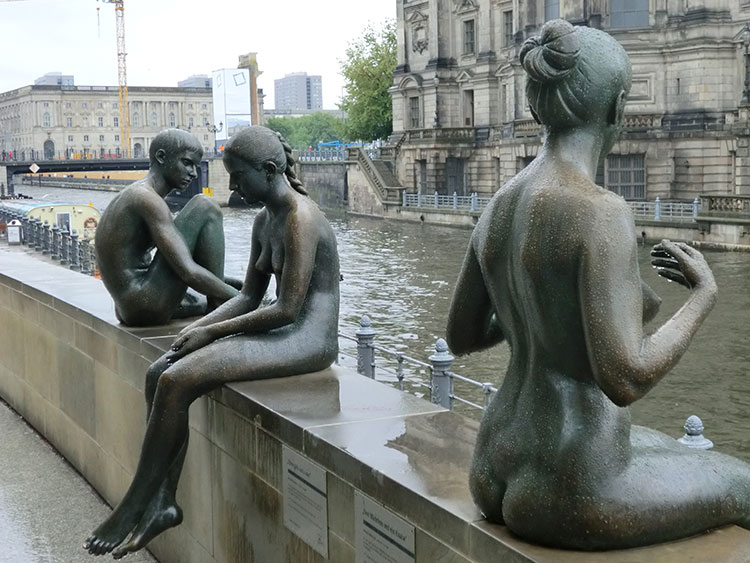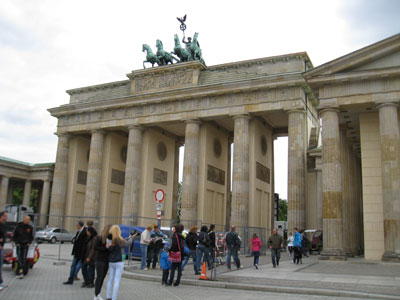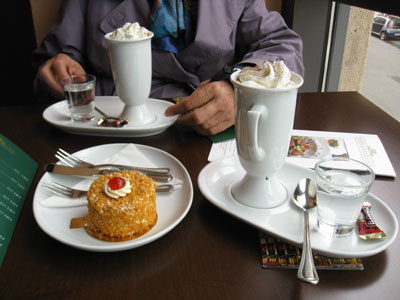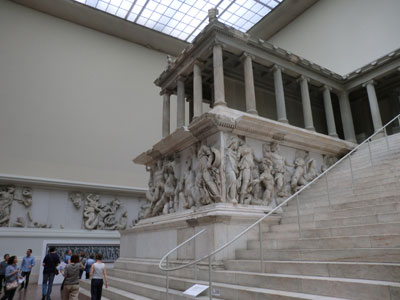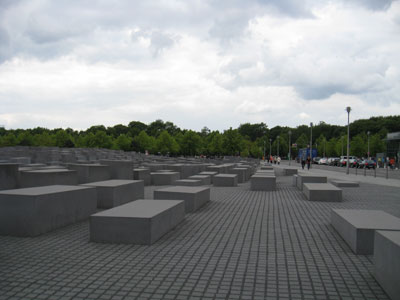Slowing down to see the sights on a week’s stay in Berlin
This article appears on page 18 of the December 2013 issue.
Arlene Lighthall — Del Mar, CA
Before my May 2013 trip to Berlin, I had visited the city twice on whirlwind tours, but I remembered little — a monument here, a museum there, a flash past a park…. Having decided to rent an apartment for a week on this trip, I spread out a large map of Berlin and marked the places I wanted to see. Chances were I wouldn’t visit all the sites on the list, but perhaps I would remember those I was able to visit.
Making plans
Because the sites were all over the city, I organized my list according to neighborhoods. On the website www.homeaway.com, I found apartments near Alexanderplatz (Alex), a hub for many forms of transportation: the U-Bahn (underground train), the S-Bahn (aboveground train), streetcars and buses.
Using the purse-size “Knopf Map Guide: Berlin” and maps from the Internet, I located the best area and booked an apartment online. The Knopf section-by-section guide also listed points of interest, including restaurants and shopping venues. In addition, I planned to take along the Lonely Planet “Berlin” guide for more information, including its introduction of the city’s historical background.
Exploring Berlin
On my first day I wanted a quick city overview, so, map in hand, I hopped onto the No. 100 bus that runs from Alexanderplatz to Zoologischer Garten station and later took the 200 bus to explore a different route. Each ticket cost €2.50 ($3.40) and was good for two hours in one direction, allowing me to get on and off.
Between Alexanderplatz and the Brandenburg Gate are the jewels of royal Berlin. Adjacent to “Alex,” the Fernsehturm (TV tower) stretches skyward above a revolving deck and restaurant offering views of the entire city. I noted that I’d need a reservation to visit the deck or the restaurant.
Just down the street, I went into the Marienkirche, a church dating back to the 13th century. The spires of both buildings are visible all along Karl Liebknechtstrasse.
Walking further to a small park, I came across a remnant of the city’s Communist days, immense sculptures of Marx and Lenin staring seriously ahead.
Glimpses of the past
The street name changed to Unter den Linden when I arrived at the Spree River. There I crossed the street to find, at a lower level, the small DDR (East German) Museum. On the upper level lounged statues of lovely bronze bathers, who needed no clothes whatever the weather.
On the opposite riverbank reigned the majestic Berliner Dom. I decided to attend a Sunday morning service there to admire its ornate interior and hear the organ of more than 7,200 pipes. The Protestant liturgy was in German, of course.
Continuing toward the Brandenburg Gate, I stopped just past it for contemplation at the Neue Wache memorial. In the middle of a bare courtyard resembling a Roman temple sat a statue of a solitary woman cradling her dead son, a soldier. In the floor beneath the two of them rest the remains of an unknown concentration camp victim and an unknown soldier, buried with soil from concentration camps and several European battlefields.
With this immense sculpture by Käthe Kollwitz, Neue Wache is aptly considered an antiwar memorial, dedicated to “the victims of war and tyranny.” On another day, I would visit the Kollwitz museum.
To the left of the Brandenburg Gate, I sauntered pensively among the 2,711 randomly placed, hollow and unmarked concrete stellae of the Holocaust Memorial, built to honor the murdered Jews of Europe.
On the opposite side of the memorial, in a peaceful garden, was the Memorial to the Sinti and Roma. A pond and inscribed black marble plaques honor these victims of the Nazis’ campaign against not only the Jews but other minorities like the Sinti and Roma. At least 500,000 “Gypsies” were sterilized or eliminated at various sites.
Returning to my apartment, I stopped off again at Marienkirche for some solitude to let the day’s impressions coalesce before getting a bite in the Platz. On a guided tour, what I had spent the day exploring on my own might have been covered in about 10 minutes.
Heading inside
I knew there would be rainy days during my visit and I had planned for them. Except for short walks, I spent one or two of those days mostly indoors at Museuminsel (Museum Island), a UNESCO World Heritage Site.
Its Bode Museum contains Byzantine art and European sculpture, while Queen Nefertiti reigns at the Neues Museum. Antiquities are the fare at the Altes Museum, and 19th-century paintings fill the Alte Nationalgalerie. The ancient treasures at the Pergamon include the massive Pergamon Altar and Babylonian Ishtar Gate on permanent display. I spent half a day at the Pergamon and half a day viewing paintings.
From “Alex,” I took the U-Bahn, for speed, to Zoologischer Garten station, although I could have taken the 100 bus. From there, I oriented myself and walked a block to the Kurfürstendamm, also known as the Ku’damm, where I turned right, continuing for two blocks to Fasanenstrasse.
On the right, in the middle of the block, sat the Käthe-Kollwitz Museum, located in a former residence. It would be an understatement to say that this artist’s work is compelling.
Several floors of charcoal drawings, lithographs and woodcuts illustrated the heartbreak of war. The love of a mother for her child, the loss of children, the plague of poverty — timeless themes that eternally plead for understanding.
Lunch at the Café im Literaturhaus in the garden next door to the museum offered just-right portions of salad.
I returned to the Ku’damm and turned left. Two blocks later a board appeared advertising the interactive museum Story of Berlin.
An inner corridor between two buildings led to an entrance on the right that was rather like the lobby of a modern theater. The museum seemed very small, but, inside, I was excited by the variety of exhibits in its many rooms.
Historical, cultural and political eras were portrayed, from the founding of the city to the destruction of The Wall. I could even enter an authentic nuclear shelter and walk over hundreds of books to remind me of those publicly burned in 1933 as an “action against the un-German spirit.” I left after several hours, having overlooked much.
The next day was somewhat gloomy when I returned to Zoologischer Garten and turned left at the Ku’damm to see the remains of the Kaiser Wilhelm Church, a monolith of rubble, standing just as it did after being bombed — a mere suggestion of its former glory. Beside it squatted a new small church, an octagonal sanctuary walled in blue glass squares of varying hues. It was well worth entering to experience the color and modern altar.
KaDeWe
In the next block, where the street became Tauentzienstrasse, I passed the shops of the Europa Center. Its highest building used to be the best place for looking over the city until The Wall came down and the Fernsehturm at Alexanderplatz took the honors.
My destination was a few blocks ahead, the amazing one-block-square shopping center called KaDeWe, Kaufhaus des Westens. Some visitors like to spend an entire day there. Each floor is a collection of high-end merchandise, beginning just inside the door with shoes priced from $400.
The usual departments of men’s and women’s clothing, rugs, housewares, etc., lie above, each floor a virtual museum, but I wanted to get to the sixth floor for its food: marzipan delights, chocolates, wines, 1,500 kinds of cheese, 1,000 varieties of sausage, 500 breads, canisters of exotic teas, counters of cakes and pastries and confections to carry home or have included in a take-out meal.
But there was more! I had heard that there were more than 30 food islands scattered among other displays. I didn’t see all of them, but I sat down at a counter to watch chefs prepare an Asian meal on the spot. I could have chosen seafood or Greek, Italian or French cuisine or any of 20 others.
Neighborhoods of note
The re-created Potsdamer Platz, aka Sony Center, was a bevy of commercial nooks for eating, shopping and watching movies, all surrounding a high, tented plaza. The restaurants were especially handy for me because, on the next block, I could view 20th-century art and German expressionism housed fittingly in the steel-and-glass Neue Nationalgalerie, designed by Mies van der Rohe. Then I could pop over to the center for a meal before attending a Berlin Philharmonic concert. Bus No. 200 stopped right outside the concert hall for the return to “Alex” after a performance.
This neighborhood, known as the Kulturforum, was good for several hours of browsing that included the Musical Instrument Museum and a concert at the St. Matthäuskirche.
Spending another whole day in a single area was no problem. The Charlottenburg Palace in the former neighborhood of Wilmersdorf is a “must” for many.
I had been there before, so I wandered in the park facing it and went directly across the street from the palace entrance to reach three good art museums: Museum Berggruen (featuring Picasso, Klee and Matisse), the Bröhan-Museum (with Art Deco furnishings) and the Sammlung Scharf-Gerstenberg (focusing on Surrealism).
I had taken the U-Bahn from “Alex” to Zoologischer Garten station, then bus No. 49 to reach the palace. There was no need to buy an additional ticket for the transfer, since I continued traveling in the same direction on public transportation.
Gendarmenmarkt is surely one of the prettiest areas to see, and nearby side streets, like Friedrichstrasse, are populated with boutiques and high-end clothing shops. Facing the market square are the Französischer Dom, the Konzerthaus Berlin and the Schiller Memorial.
Asking the location of Fassbender & Rausch, I learned it was on a corner just behind the concert hall.
Supposedly the largest chocolaterie in the world, it was high on my must-see list. The variety of concoctions was endless, in flavors and shapes each more tempting than the first. It was easy to fill my bag and empty my wallet, but first came a visit upstairs for hot chocolate with peppermint liquor (€4.70) and a nut-crusted cake of buttercream and raspberry jam (€3.95).
It wasn’t far from there to the Emil Nolde Museum. Most of his paintings on display are of small statues collected on his travels, coupled with flowers. I enjoyed watching a film demonstrating his painting technique and highlighting some of his other works.
Remembering East Germany
For a relaxing hour’s self tour and a revealing glimpse of the former East Germany, I took Tram M6 eastward in the direction of Poland to Landsberger Allee. I passed miles and miles of monotonous, mass-produced apartment buildings stacked several stories high to house the millions who were displaced after 1945.
When I visited East Berlin in 1971, our guide tried to impress the West Germans on the tour with Communist-propaganda statistics, such as how residents paid just $30 a month for a small apartment in just such a building. This time I was there to touch base with someone I had mentioned in a book I recently published on Germany.
With so much to see in this big city, I had to plan each day’s itinerary in advance. To save time and transportation costs, I concentrated my sightseeing on areas where several attractions were in close proximity. Along the way, I enjoyed happening upon restaurants and coffee shops. Having been my own tour guide, I knew I would remember where I had been.

